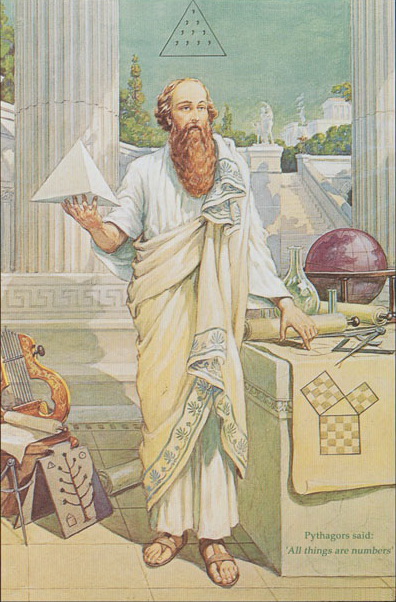Site about Music - Art & Math


 (/pɪˈθæɡərəs/; Ancient Greek: Πυθαγόρας ὁ Σάμιος Pythagóras ho Sámios “Pythagoras the Samian”, or simply Πυθαγόρας; Πυθαγόρης in Ionian Greek; c. 570 BC – c. 495 BC)[1][2] was an Ionian Greek philosopher, mathematician.
(/pɪˈθæɡərəs/; Ancient Greek: Πυθαγόρας ὁ Σάμιος Pythagóras ho Sámios “Pythagoras the Samian”, or simply Πυθαγόρας; Πυθαγόρης in Ionian Greek; c. 570 BC – c. 495 BC)[1][2] was an Ionian Greek philosopher, mathematician.
Pythagoras's father was Mnesarchus ([12] and [13]), while his mother was Pythais [8] and she was a native of Samos. Mnesarchus was a merchant who came from Tyre, and there is a story ([12] and [13]) that he brought corn to Samos at a time of famine and was granted citizenship of Samos as a mark of gratitude.
Around 530 B.C., the Greek mathematician Pythagoras moved to Croton, Italy to teach mathematics, music, and reincarnation. Pythagoras is usually credited with discovering mathematical relationships relevant to musical harmonies. For example, he observed that vibrating strings produce harmonious sounds when the ratios of the lengths of strings are whole numbers. He also studied triangular numbers ( based on patterns of dots in a triangular shape) and perfect numbers ( integers that are the sum of their proper positive divisors). Although the famous theorem that bears his name, a2+b2=c2 for a right triangle with legs a and b and hypotenuse c, may have been known to the Indians and Babylonians much earlier, some scholars have suggested that Pythagoras or his students were among the first Greeks to prove it.
According to legend, the way Pythagoras discovered that musical notes could be translated into mathematical equations was when he passed blacksmiths at work one day and thought that the sounds emanating from their anvils were beautiful and harmonious and decided that whatever scientific law caused this to happen must be mathematical and could be applied to music. He went to the blacksmiths to learn how the sounds were produced by looking at their tools. He discovered that it was because the hammers were "simple ratios of each other, one was half the size of the first, another was 2/3 the size, and so on".
This legend has since proven to be false by virtue of the fact that these ratios are only relevant to string length (such as the string of a monochord), and not to hammer weight.[65][66] However, it may be that Pythagoras was indeed responsible for discovering the properties of string length.
Pythagoreans elaborated on a theory of numbers, the exact meaning of which is still debated among scholars. Another belief attributed to Pythagoras was that of the "harmony of the spheres". Thus the planets and stars moved according to mathematical equations, which corresponded to musical notes and thus produced a symphony.[67]
Pythagoras was also credited with devising the tetractys, the triangular figure of four rows which add up to the perfect number, ten. As a mystical symbol, it was very important to the worship of the Pythagoreans who would swear oaths by it.